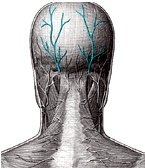 A new study published last year shows the massage can reduce migraine headaches. The article is titled “Massaging Over the Greater Occipital Nerve Reduces the Intensity of Migraine Headaches.” (1) Good news for you….massage feels great and can help you relieve pain!
A new study published last year shows the massage can reduce migraine headaches. The article is titled “Massaging Over the Greater Occipital Nerve Reduces the Intensity of Migraine Headaches.” (1) Good news for you….massage feels great and can help you relieve pain!
To better understand how massage can help your migraines, let’s have a simple anatomy lesson. I am assuming you don’t know where the greater occipital nerve is. And since random rubbing hasn’t proven to be effective for migraines, you probably will want to know where to massage or be massaged.
The Greater Occipital Nerve (GON) runs through the middle of the Suboccipital Triangle- four small muscles on either side of the upper neck. The GON innervates the scalp and areas over the ears. When our neck muscles get tight, epecially our occipital muscles (think base of the skull), irritation of the GON occurs. And you know what that means…a headache!
Tight muscles and nerve irritation can make even the happiest person miserable. The benefits of massage are unmistakable- muscle relaxation, increased blood flow, and stress-reduction. Now you can add headache relief to one of its many benefits.
 Self-Massage or Partner Massage
Self-Massage or Partner Massage
1. Start massaging the neck and shoulders
2. Work your way up to the base of your neck (where the GON starts). Focus on any areas that are painful and tight. Many headache suffers have knots in their muscles, called trigger points. If someone pushes and holds a trigger point, you will feel the pain shoot up the head and recreate the headache. That’s the spot that should be relaxed with massage.
3. Finish up by massaging the scalp where the GON nerve endings are located.
To learn more about headache help or to book an appointment for a professional therapeutic massage and treatment, visit http://www.TranquilityCS.com.
(1) Piovesan, et al. Massaging Over the Greater Occipital Nerve Reduces the Intensity of Migraine Headaches. Arq Neuropsiquiatr 2007;65(3-A):599-604.* Full free article- http://www.scielo.br/pdf/anp/v65n3a/10.pdf
